What Is Concrete | 31 Different Types of Concrete
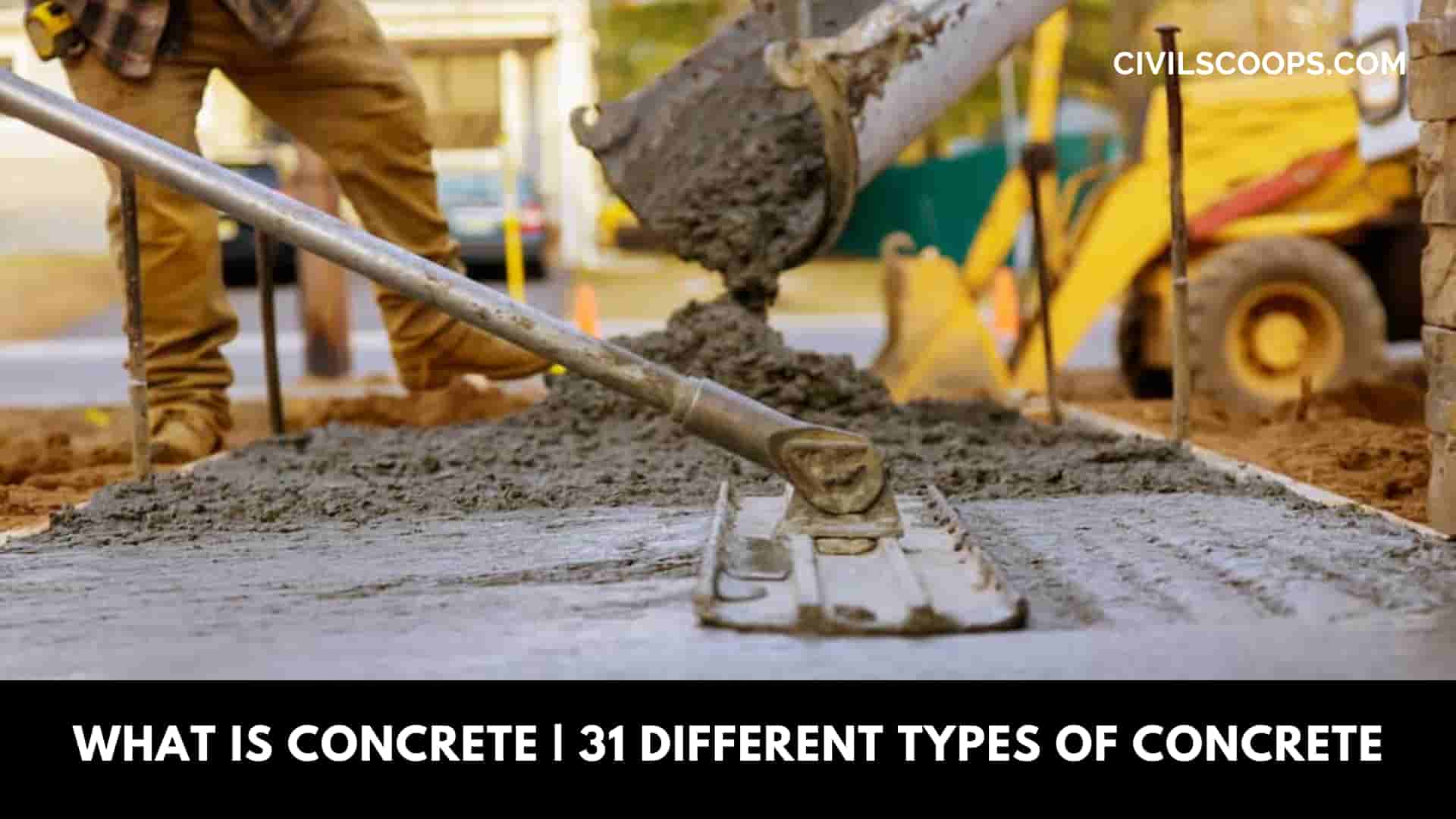
Table of Contents
What Is Concrete?
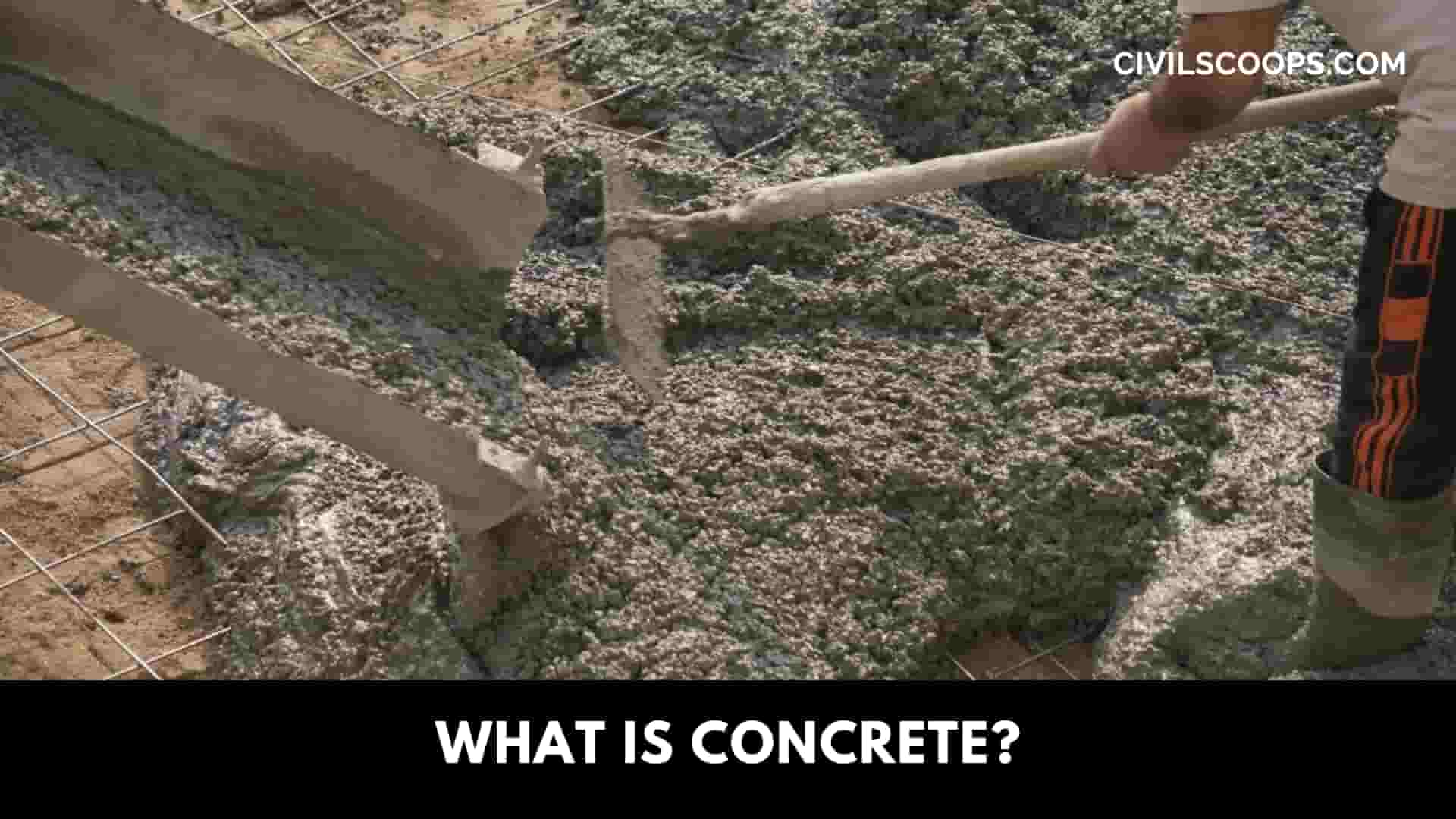
Concrete is the final product resulting from mixing cement, aggregates (including sand), water, and mixtures. It is initially malleable in its “wet” state and solidifies over time, gaining strength and durability.
The first use of concrete was by the Roman Empire. Although there is some indication that earlier civilizations used a distant form of concrete, the Romans used a mixture of quick lime, pozzolana, and a pumice aggregate.
The Pantheon is the largest unreinforced concrete dome in the world, built-in 120 A.D.
Also Read: All About Grillage Foundation | Types of Grillage Foundation | Features of Grillage Foundation
Different Types of Concrete

- Air Entrained Concrete.
- Decorative Concrete.
- Dry lean Concrete. / Roller Compacted Concrete.
- Asphalt Concrete.
- Cold Mix Asphalt.
- Hot Mix Asphalt.
- Warm Mix Asphalt.
- Ferro Cement Concrete.
- Fiber Reinforced Concrete (FRC).
- Fly Ash Concrete.
- Glass Concrete.
- High-density Concrete.
- High Strength Concrete.
- Insulating Concrete.
- Light-weight Concrete.
- Lime Concrete.
- Normal Strength Concrete.
- Permeable Concrete.
- Pervious Concrete.
- Plain or Ordinary Concrete.
- Plum Concrete.
- Polymer Concrete.
- Partially-impregnated and surface-coated polymer concrete.
- Polymer impregnated concrete (PIC).
- Polymer Portland cement concrete (PPCC).
- Polymer concrete (PC).
- Prestressed Concrete.
- Precast Concrete.
- Pre-Packed Concrete.
- Rapid Hardening Concrete.
- Ready Mix Concrete.
- Reinforced Concrete.
- Stamped Concrete.
- Self-Compacting Concrete.
- Shotcrete Concrete.
- Silica Fume Concrete.
- Smart concrete.
- Vacuum Concrete.
1. Air Entrained Concrete

These are concrete types to which air is intentionally entrained for a period of 3 to 6% of the concrete. The air entrainment from the concrete is achieved by the addition of foams or gas foaming agents.
A few examples of air-entraining agents are resins, alcohols, and fatty acids.
Air Entrained Concrete Density: 1840-2400 Kg/m3
2. Decorative Concrete
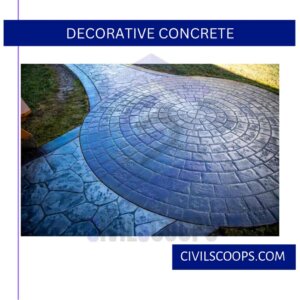
Decorative concrete in the form of concrete that has been treated in many different ways to increase its aesthetic appeal.
For instance, it may go through procedures like coloring, texturing, molding, polishing, embossing, etching, embedding items, applying decorative toppings, and so on.
Various materials are used in producing decorative concrete like colour hardener that offers a unique colour as well as a highly durable surface; Integral colour is usable on any texture and application.
Finally, chemical stain gives a natural stone look by producing an uneven, translucent color. Therefore, decorative concrete is ideal for projects where you are looking to make a decorative impact.
It’s also utilized to add components of dynamism to unexciting surfaces as well as material. Some common applications include decorative flooring, swimming pools, paving, and implement architectural features.
3. Dry lean Concrete / Roller Compacted Concrete
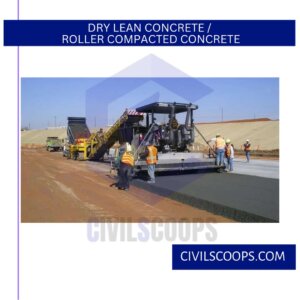
These are concrete that’s placed and compacted with the help of earth-moving equipment like heavy rollers. This concrete is mainly employed in excavation and filling needs.
These concretes have cement content in a lesser amount and filled to your area necessary. After compaction, this concrete provides high density and finally cures into a strong monolithic block.
4. Asphalt Concrete

Asphalt concrete, more commonly called just asphalt, is a composite material used in the construction of roads, highways, airports, parking lots, and other kinds of pavements.
The use of asphalt for street construction began in the late 1800s and the market for asphalt expanded as the automobile industry grew.
Since then, there have been enormous strides in the development of asphalt technology. Today, highly sophisticated equipment and processes are used to construct asphalt pavements.
Asphalt is known to carry a number of desirable properties like durability, workability, fatigue resistance, skid resistance, stability, impermeability, and flexibility.
But to make sure that these properties function, asphalt concrete mixture has to be properly designed, produced, and placed.
Different kinds of asphalt mixes are designed to serve various functions. For instance, the base asphalt mixes have entirely different functions in pavement structure than asphalt surface mixes.
Thus, both are produced differently. Various different kinds of asphalt concrete mixes are available to create unique structures.
For instance, the asphalt mix used in the construction of roads must withstand tough weather conditions and high traffic.
Thus, to cope with the applied pressure from vehicle wheels, it ought to be sufficiently stiff, and to resist cracking exerted by other pressures, it ought to possess adequate flexural strength.
Hot mix asphalt is the ideal mix for these high-traffic roads. Following are the three different kinds of asphalt mixes available
4.1. Cold Mix Asphalt
Cold mix asphalt is widely used for roads with lighter vehicle traffic. Its production does not require heating as it uses a specific bitumen emulsion.
The emulsion breaks during compaction or mixing and coats the aggregate. Over time, this coating increases the asphalt’s strength.
4.2. Hot Mix Asphalt
Hot mix asphalt is produced in extremely high temperatures between 150°C and 190°C.
Based on the usage, various mixtures can be made including porous asphalt, asphalt concrete for very thin layers, double-layered porous asphalt, and so on.
4.3. Warm Mix Asphalt
Unlike hot mix asphalt, warm mix asphalt uses lesser energy and is produced in 20°C into 40°C of temperatures.
The temperature is low during the paving operations, ensuring safety for the working team and earlier opening of the road to be used.
5. Ferro Cement Concrete
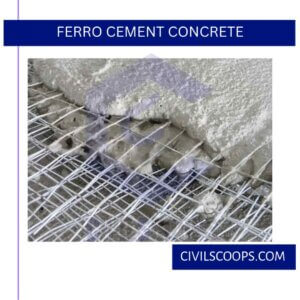
Ferro cement concrete shouldn’t be confused with fiber concrete. Ferro cement consists of closely spaced wire-meshes that are impregnated with a rich mix of cement mortar.
Usually, 0.5 to 1.0 mm diameter steel wires are shaped into meshes. Mortar 1:2 to 1:3 using a water-cement ratio of 0.4 to 0.45 is poured to the form-work with fabricated steel by using layers of the wire mesh.
The steel content of the concrete will be as high as 300 to 500 kg/m3 of mortar. As the material consists of a large percentage of steel, it has high ductility and tensile strength.
The material was developed in 1940 by the Italian architect P. L. Nervi to build a large number of pleasing structural forms.
Also Read: What Is Plaster | Methods of Plastering
6. Fiber Reinforced Concrete (FRC)
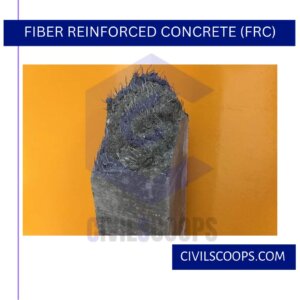
It is that type of concrete where steel fibers 10 to 20 microns in diameter and 10 to 50 mm in length are used. Fiber increases resilience, tensile strength, flexibility, along with other qualities.
The fibers may be of different materials such as steel, polymer, glass, carbon, or even natural fibers such as coconut fiber.
Some types of fibers react with the cement; special care ought to be taken while using them. It has been used mostly as overlays for pavements in airports, bridges, and more than industrial floors.
Fiber-reinforced concrete may also be used in places where increased resistance to cracking is required.
7. Fly Ash Concrete
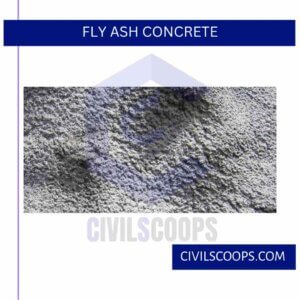
Concrete with fly ash is known as fly ash concrete. Fly ash is obtained from coals. Fly ash may be used to replace fine aggregates or cement or to replace partially both.
As much as 30 percent replacement of fine aggregates and 20 percent replacement of cement are reported.
Fly ash improves workability from the fresh concrete and strength and durability within hardened concrete.
The particles of fly ash must be finer than of cement particles.
8. Glass Concrete
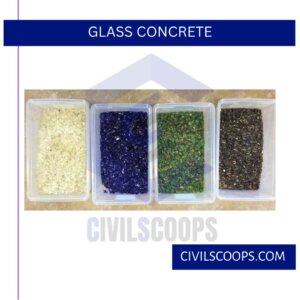
If the recycled glass is used as an aggregate in the concrete, this kind of concrete is called Glass Concrete.
They provide better thermal insulation and also have a great appealing look as compared to other types.
9. High-density Concrete

This type of concrete can also be called heavy-weight concrete. Within this concrete type, the density varies between 3000-4000 Kg/m3.
These kinds of concrete are prepared by using high density crushed rocks as coarse aggregates. One of such materials, Barytes is the most widely used material, that has a specific gravity of 4.5.
They are mostly used in atomic power plants and other similar structures because it provides good protection from all kind of radiations.
High-Density Concrete Density: 3000 – 4000 Kg/m3
10. High Strength Concrete
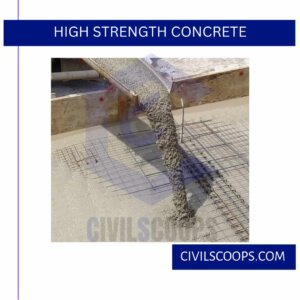
This concrete conforms to a particular standard but in no case, will be limited to strength. It has to be noted that all the high strength concrete could be a high-performance type.
However, not all high-performance concrete (HPC) are high strength concrete.
Standards that conform to This high-performance concrete are enlisted below:
- Environmental concerns
- Toughness and life term mechanical properties
- Long life and durability
- Heat of hydration
- Permeability and density factors
- Easy placement of the concrete
- Strength gain an early age
11. Insulating Concrete
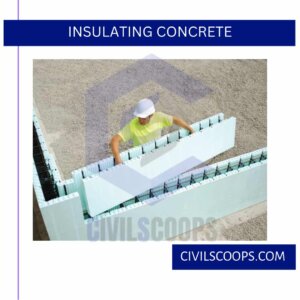
As its name suggests, insulating concrete form systems provide insulating properties such as the concrete walls of a structure below and above grade.
In residential construction, regular concrete foundation walls often require the installation of insulation after the forms are removed.
With ICFs, since the insulation remains in place, the insulation installation isn’t required. Insulated concrete forms are lightweight, and lots of systems are erected like toy building blocks making them easy to install.
Insulating concrete forms may be used for residential below-grade foundations and above-grade walls up to two stories. Engineering designs could be required for larger structures.
12. Light-weight Concrete
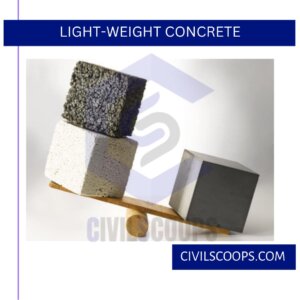
Concrete which has a density lesser than 1920kg/m3 will be categorized as lightweight concrete. Using lightweight aggregates in concrete design will give us lightweight aggregates.
Aggregates will be an important element that contributes to the density of the concrete. The examples of light-weight aggregates are the pumice, perlites, and scoria.
The light-weight concrete is applied for the protection of the steel structures and can also be used for the construction of the long-span bridge decks. These can also be used for the construction of the building blocks.
Lightweight Concrete Density: 1440 – 1920 Kg/m3
13. Lime Concrete
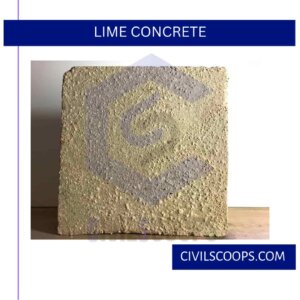
In this kind of concrete, lime can be used as a binding material with the aggregates. Before the invention of cement, the most used concrete was lime concrete.
The most important application of this product is on floors, domes as well as vaults. These unlike cement have lots of environmental and health benefits. These products are renewable and easily cleaned.
14. Normal Strength Concrete
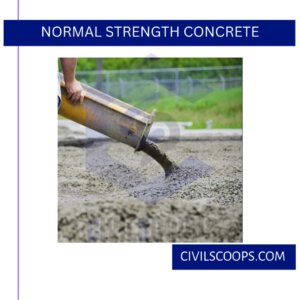
The concrete that’s obtained by mixing the fundamental ingredients cement, aggregate, and water will give us normal strength concrete.
The strength of this kind of concrete will be different from 10 MPa to 40MPa.
The normal strength concrete comes with an initial setting time of 30 to 90 minutes which is dependent on the cement properties and the weather conditions of the construction site.
15. Permeable Concrete

Permeable concrete is ready in such a manner that the water could be passed inside. They have about 15 to 20% voids so that the water may pass inside.
They are used in those areas where stormwater issues persist.
16. Pervious Concrete

Pervious concrete is another type of concrete used in the construction of roads and pavements. It’s designed to overcome the problems of storm-water runoff and replenishment of local watersheds.
Pervious concrete has the capability to absorb water rather than allowing it to puddle. This helps reduce hydroplaning, snow buildup, and tire spray, making the pavements safer for pedestrians and drivers.
This also helps reduce the need for storm sewers and curbing. It is the structure of the concrete which gives it the property of water absorption.
Like other kinds of concrete, pervious concrete is made of a mixture of cement, water, and coarse aggregates. However, the mix contains no sand, leading to a porous open-scale structure, allowing water to pass through easily.
Some kinds of porous pavement made from pervious concrete may allow 3-5 gallons of water to pass through per minute, making it an ideal structure to control stormwater drainage.
Pervious concrete pavements also offer improved filtration and the ideal amount of surface area to catch chemical pollutants and oil, which is not the case with traditional asphalt or concrete.
While previous concrete is ideal for pavements and low-volume applications like residential streets and parking lots, it is not appropriate for full-scale use on high-traffic roadways.
This is because its void structure does not have load-bearing properties that other kinds of concrete possess.
17. Plain or Ordinary Concrete

The plain concrete will have no reinforcement within it. The main constituents are cement, aggregates, and water. The most commonly used mix design is 1:2:4 that’s the normal mix design.
The density of the plain or ordinary concrete will vary between 2200 and 2500 Kg/m3. The compressive strength is 200 to 500 kg/ cm2
These kinds of concrete are mainly utilized in the construction of the pavements along with the buildings, especially in areas where there is less demand for high tensile strength.
The durability given by these kinds of concrete is satisfactory to a high extent.
Plain or Ordinary Concrete.Density: 2200 – 2500 Kg/m3
18. Plum Concrete
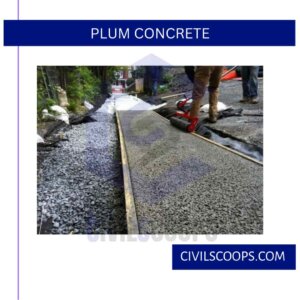
In some mass concrete foundations, boulders of say 150 mm size up to 30% of the total quantity of concrete, are mixed in the wet concrete. This adds to economics and saves heat generation.
Such concretes are called plum concretes.
After at least two layers of wet concrete is completed, well-shaped and thoroughly washed, angular rock pieces using a maximum size of not more than 60% of a layer of pour thickness are placed in the concrete, keeping a distance of more than one-and-a-half times of the biggest size of aggregates in the concrete.
The bottom of the boulders should be embedded in the wet concrete to avoid voids at the bottom. Concreting is continued without stopping. These rock pieces become an integral part of a concrete structure.
19. Polymer Concrete
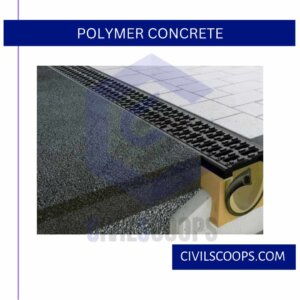
Polymerization is a process of conversion of monomers to polymers. In normal concrete, you need to have seen that micro-pores can’t be avoided.
The impregnation of monomer to those pores and subsequent polymerization is the technique that’s been developed recently to reduce the porosity of the concrete and to improve its strength and other properties.
The following are the four kinds of polymer concrete materials available at present.
19.1. Partially-impregnated and surface-coated polymer concrete
This name is self-explanatory. These materials at present are mostly used in building construction only to improve durability or repairs works.
19.2 Polymer Impregnated Concrete (PIC)
This concrete type is ordinary-cured concrete, that can be dried in an oven, as well as the air at the open cells, is removed from the vacuum.
A low viscosity monomer is introduced into these spaces, which is then polymerized by the application of chemical heat or action or by using radiation.
19.3. Polymer Portland Cement Concrete (PPCC)-
These kinds of concrete are made by mixing a monomer along with the mixing of aggregates, cement, and water.
However, the concrete obtained in this way isn’t as strong as the impregnated-type.
19.4. Polymer Concrete (PC)
In this kind of concrete, instead of cement, the polymer can be used using the aggregates. It’s not a true concrete as used in civil engineering terminology.
Also Read: All About Drywall Water Damage Repair
20. Prestressed Concrete
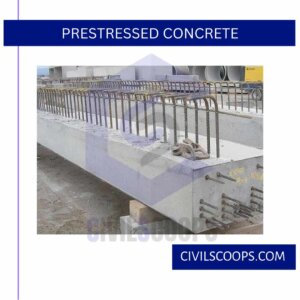
Most of the mega concrete projects are carried out through prestressed concrete units. This is a special technique where the bars or the tendons used in the concrete are stressed before the actual service load application.
Throughout the mixing and the placing of the concrete, these tensioned bars placed firmly and held from every end of the structural unit.
When the concrete sets and harden, the structural unit will be put in compression. This phenomenon of prestressing will make the lower section of the concrete member to be stronger against the tension.
The process of prestressing will require heavy equipment and labour skill (jacks and equipment such as tensioning). Therefore the prestressing units are made at and assembled at site.
These are used in the application of bridges, heavily loaded structures, and roofs with longer spans.
21. Precast Concrete
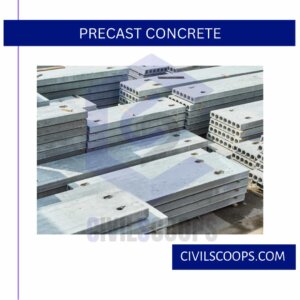
Various structural elements could be made and cast in the factory as per the specifications and bought into the site in the time of assembly.
Such concrete units are known as the precast concrete. The examples of precast concrete units are concrete blocks, the staircase units, precast walls and poles, concrete lintels, and many other elements.
These units have the advantage of acquiring speedy construction as the only assemblage is necessary. As the manufacturing is done on the site, quality is assured. The only precaution taken is for their transportation.
22. Pre-Packed Concrete
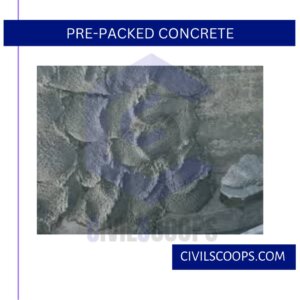
Usually, concrete is prepared by mixing different ingredients. But it’s also possible to pack some of the ingredients (coarse aggregate) from the form-work and then fill the pores using specially prepared cement-sand grout so that it will fill all the pores and form a concrete mass.
Pre-packed concrete is used in special situations like in which a large volume of concrete (such as a large machine block foundation) has to be concreted without construction joints.
One of the advantages of pre-packed concrete is that it has very little shrinkage.
23. Rapid Hardening Concrete
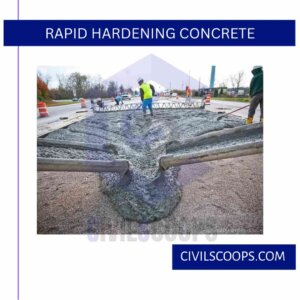
As its name implies these concretes will acquire strength with few hours after its manufacture. Thus the formwork removal is made easy and thus the building construction is covered fastly.
These have a wide-spread application from the road repairs since they may be reused following few hours.
24. Ready Mix Concrete
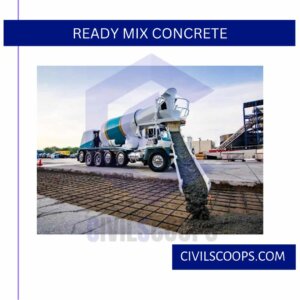
The concrete that mixes and bathed in a central mixing plant is known as ready-mix concrete. The mixed concrete is brought into the site with the help of a truck-mounted transit mixer.
This once reached in the site may be used directly without any further treatment. The ready-mix concrete is very precise and specialty concrete could be developed depending on the specification with utmost quality.
The manufacture of that concrete will require a centralized mixing plant. These plants will be located at an adjustable distance from the construction site. If the transportation is too long then it will result in setting of concrete.
Such issues of time delay are coped up with the use of retarding agents that delay the setting.
25. Reinforced Concrete
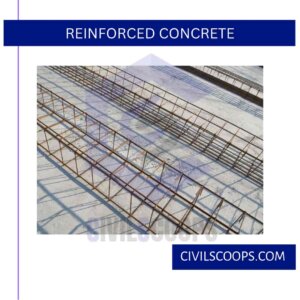
It’s also called RCC (Reinforced Cement Concrete). Within this concrete type, steel in various forms can be used as reinforcement to give very high tensile strength.
In fact, it is due to the combined action of plain concrete (having high compressive strength) and steel (having high tensile strength).
The steel reinforcement is cast in the form of bars, sticks, meshes, and all conceivable shapes. Every care is taken to ensure the maximum bond between the reinforcement and the concrete through the setting and hardening process.
Therefore, the resulting material (RCC) is capable of bearing all kinds of stress in any type of construction. RCC is the most important concrete type.
26. Stamped Concrete
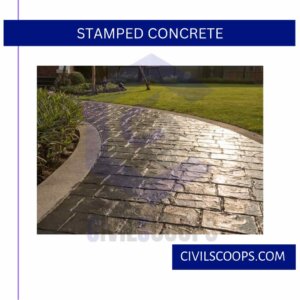
Stamped concrete is an architectural concrete where realistic patterns similar to natural stones, granites, and tiles can be obtained by placing an impression of professional stamping pads.
This stamping is performed on the concrete if it’s in its plastic condition. Different coloring stains and texture work will finally give a finish that’s very like costlier natural stones.
A high aesthetic look can be obtained from a stamped finish economically. This can be used in the construction of driveways, interior floors, and patios.
27. Self-Compacting Concrete
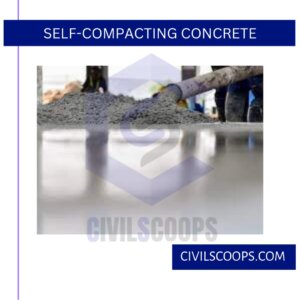
The concrete mix when placed will compact with its own weight is regarded as self-compacting concrete. No vibration has to be provided for the same separately.
This mix has higher workability. The slump value will be between 650 and 750. This concrete due to its higher workability can also be known as flowing concrete.
The areas where there is thick reinforcement, self-compacting concrete works best.
28. Shotcrete Concrete
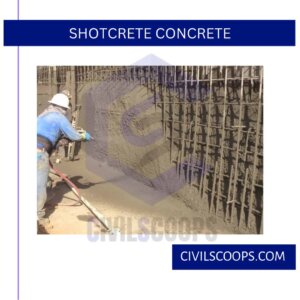
Shotcrete is a concrete prepared in the same manner as ordinary, however, the difference is that they are placed differently.
They’re placed with the help of higher air pressure through nozzles. The benefit of this technique is that the compaction and placing of concrete will be done simultaneously.
29. Silica Fume Concrete
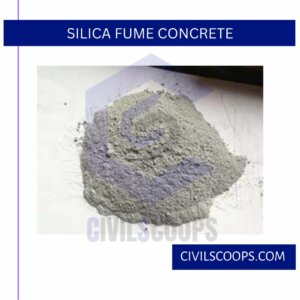
Silica fume is a byproduct of silica that’s very finely divided into the industry. The concrete where silica fume can be used is known as “silica fume concrete”.
The typical concrete using a normal water-cement ratio always has micro-pores, which limits the strength of regular concrete.
Silica fumes consist of very fine particles (actually, 6 times finer than of cement particles). Hence, if it is added to the concrete mix, the minute pore spaces can be reduced, resulting in high-strength concrete.
Silica fume can be a pozzolana which will contribute to the strength. Therefore, silica fume, along with super- plasticizers is a necessary component of high-performance and high-strength concrete.
30. Smart Concrete
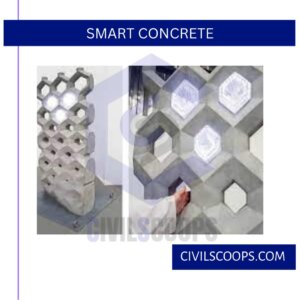
Smart concrete technology offers an alternative method for monitoring the health of reinforced concrete structures.
It works by adding a small quantity of short carbon fiber to concrete using a conventional concrete mixer that modifies the electrical resistance of the concrete in response to stress or strain.
This may be used to monitor stress or strain from concrete structures, identifying potential problems before the concrete fails.
Smart concrete is capable of sensing very small structural flaws and hence finds application in checking the internal condition of constructions, particularly after an earthquake.
Smart concrete technology has undergone extensive laboratory testing, however, is yet to hit the market.
31. Vacuum Concrete

Vacuum concrete in the form of concrete where the excess water has been removed to improve concrete strength. All the water used for mixing isn’t required for hydration so it’s removed before hardening takes place.
To remove the water, vacuum pumps containing vacuum mats are generally used. Not only is the final strength of this vacuum concrete improved by 25%, but its stiffening pace also improves such that the form-works could be removed within 30 minutes of casting even on high columns. This allows frequent reuse of forms, making it extremely economical.
Vacuum concrete is characterized by higher density and increased bond strength. It can also be used for resurfacing old surfaces since it bonds well with old concrete.
Vacuum concrete is ideal for structures that frequently subject to flowing water at high velocity. This is because the uppermost 1/16 inch of its surface is highly resistant to abrasion and the whole surface is usually free of pitting.
Types of Concrete

- Air Entrained Concrete: Some types of concrete hold billions of microscopic air cells in every cubic foot. These tiny air pockets relieve the internal pressure on the concrete. They provide tiny chambers where water can expand when it freezes. The air is entrained in the concrete by adding various foaming agents such as alcohols, resins, or fatty acids during the mixing process. This must be done under careful engineering supervision since the concrete is mixed on the job site.
- Decorative Concrete: Decorative concrete creates visually and aesthetically appealing concrete mixes. Decorative concrete can go through several processes, such as Coloring, Molding, Polishing, Etching, Applying decorative toppings. It is ideal for any project in which you want to make an aesthetic statement. It’s also a great way to add a bit of “personality” to dull surfaces or structures. For instance, swimming pools and flooring can make great use of decorative concrete.
- Roller Compacted Concrete: It’s a familiar sight on many American highways — a heavy roller compacting a layer of concrete. Roll-compacted concrete is a strong, dense concrete used on heavily trafficked highways with vehicles that carry large loads. This concrete emits fewer emissions during the production process, which benefits the environment.
- Asphalt Concrete: More commonly known as “asphalt” or “blacktop,” this is a form of concrete frequently used on roads, on airport runways, on highways, in parking lots, for sidewalks — basically anywhere pavement is needed. Asphalt is a dark mineral composed of a mixture of hydrocarbons called bitumens.
- Ferro Cement Concrete: Highly versatile form of reinforced concrete. It’s a type of thin reinforced concrete construction, in which large amount of small diameter wire meshes uniformly throughout the cross section. Mesh may be metal or suitable material. Instead of concrete Portland cement mortar is used.
- Fiber Reinforced Concrete (FRC): The steel fiber used in concrete can generally increase the tensile strength by about 2 times, the bending strength by 1.5 ~ 2.5 times, the impact strength by more than 5 times or even 20 times, the ductility by 4 times, and durability by 100 times above.
- Fly Ash Concrete: Fly ash use in concrete improves the workability of plastic concrete, and the strength and durability of hardened concrete. Fly ash use is also cost effective. When fly ash is added to concrete, the amount of portland cement may be reduced. Benefits to Fresh Concrete.
- Glass Concrete: Another, more modern form of concrete, glass concrete features the use of recycled glass. This form of concrete is used when an aesthetic appeal is an important element in the design of the concrete.
- High-density Concrete: High–density concrete or heavyweight concrete is produced using special heavy aggregates (with specific gravities higher than 3000 kg/m3). EN 206:2013+A1:2016 (2016) defines heavyweight concrete as having an oven dry density greater than 2600 kg/m3. The density achieved will depend on the type of aggregate used.
- High Strength Concrete: High-performance concrete is a term used to describe concrete with special properties not attributed to normal concrete. High–strength concrete is typically recognized as concrete with a 28-day cylinder compressive strength greater than 6000 psi or 42 Mpa.
- Insulating Concrete: Insulating concrete form or insulated concrete form (ICF) is a system of formwork for reinforced concrete usually made with a rigid thermal insulation that stays in place as a permanent interior and exterior substrate for walls, floors, and roofs.
- Light-weight Concrete: Lightweight concrete is a mixture made with lightweight coarse aggregates such as shale, clay, or slate, which give it its characteristic low density. Structural lightweight concrete has an in-place density of 90 to 115 lb/ft³, whereas the density of regular weight concrete ranges from 140 to 150 lb/ft³.
- Lime Concrete: Lime mortar today is primarily used in the conservation of buildings originally built using lime mortar, but may be used as an alternative to ordinary portland cement. It is made principally of lime (hydraulic, or non hydraulic), water and an aggregate such as sand.
- Normal Strength Concrete: The compressive strength of normal concrete is between 20 and 40 MPa. The strength of high strength concrete is above 40 MPa.
- Permeable Concrete: Permeable concrete is a durable concrete pavement with a large volume of interconnected voids. Like conventional concrete, it is made from a mixture of cement, coarse aggregates, and water. However, it contains little or no sand, which results in a porous open-cell structure that allows water to pass through readily.
- Pervious Concrete: Pervious concrete has a common strength of 600–1,500 pounds per square inch (4.1–10.3 MPa) though strengths up to 4,000 psi (28 MPa) can be reached. There is no standardized test for compressive strength.
- Plain Concrete: Plain concrete, also known as plain cement concrete or PCC, is most commonly used for paving and flooring. Made from a mix of cement, aggregate, and water the different types of aggregate and ratio of materials used will give different types of cement with slightly different properties.
- Plum Concrete: It is formed by amalgamating coarse aggregate and cement which are set underneath the foundation or footing of a structure in order to attain a level surface for allocating the load equally. The plum concrete is actually an inexpensive variation of mass concrete.
- Polymer Concrete: Polymer concrete is a composite material in which the aggregate is bound together in a matrix with a polymer binder. The composites do not contain a hydrated cement phase, although portland cement can be used as an aggregate or filler.
- Prestressed Concrete: Prestressed concrete is a structural material that allows for predetermined, engineering stresses to be placed in members to counteract the stresses that occur when they are subject to loading. It combines the high strength compressive properties of concrete with the high tensile strength of steel.
- Precast Concrete: Precast concrete is a construction product produced by casting concrete in a reusable mold or “form” which is then cured in a controlled environment, transported to the construction site and lifted into place (“tilt up”). More recently expanded polystyrene is being used as the cores to precast wall panels.
- Pre-Packed Concrete: Prepacked aggregate concrete (PAC) is a type of concrete that is placed in two stages where the coarse aggregates are first placed inside the formworks and then the grout is pumped from underneath through a manual pump.
- Rapid Hardening Concrete: Rapid Hardening Portland Cement (RHPC) is a special purpose cement used in concrete to achieve a higher rate of early strength development, compared to using Normal Cement. The improved early performance of RHPC is achieved principally through increased product fineness.
- Reinforced Concrete: Reinforced concrete, concrete in which steel is embedded in such a manner that the two materials act together in resisting forces. In reinforced concrete, the tensile strength of steel and the compressive strength of concrete work together to allow the member to sustain these stresses over considerable spans.
- Stamped Concrete: Stamped concrete is one of the most popular patio and deck materials worldwide. It is slightly cheaper than pavers and offers a variety of colors and patterns. Since stamped concrete is in fact concrete, it will crack at some point. Installers will try to combat this issue by placing control joints every few feet.
- Self-Compacting Concrete: Self–Compacting Concrete (SCC) is defined as concrete that has an ability to flow under its own weight, to fill the required space or formwork completely and to produce a dense and adequately homogenous material without a need for vibrating compaction.
- Shotcrete Concrete: Shotcrete, also called (trademark) Gunite, concrete applied by spraying. Shotcrete is a mixture of aggregate and portland cement, conveyed by compressed air to the nozzle of a spray gun, where water is added. The wet mixture is then sprayed in place and may be carved or troweled almost immediately.
- Silica Fume Concrete: Silica fume, a by-product of the ferrosilicon industry, is a highly pozzolanic material that is used to enhance mechanical and durability properties of concrete. It may be added directly to concrete as an individual ingredient or in a blend of portland cement and silica fume.
- Smart Concrete: Abstract Smart concretes and structures are intelligent systems that have properties different from normal concrete, such as self- sensing and self-healing properties, or have the ability to react upon an external stimulus, such as stress and temperature.
- Vacuum Concrete: Vacuum concrete is the one from which water is removed by vacuum pressure after placement of concrete structural member. Vacuum concrete has high strength and durability than normal concrete. Water-cement ratio is detrimental for concrete. These pores result into high permeability and less strength in the concrete.
[su_box title=”FAQ” style=”default” box_color=”#333333″ title_color=”#FFFFFF” radius=”3″ class=”” id=””]
What Is Concrete Made of?
To make concrete a mixture of portland cement (10-15%) and water (15-20%) make a paste. This paste is then mixed with aggregates (65-75%) such as sand and gravel, or crushed stone. As the cement and water mix, they harden and bind the aggregates into an impenetrable rock-like mass.
Shotcrete
Shotcrete, gunite (/ˈɡʌnaɪt/), or sprayed concrete is concrete or mortar conveyed through a hose and pneumatically projected at high velocity onto a surface, as a construction technique, first used in 1907 invented by Carl Akeley. It is typically reinforced by conventional steel rods, steel mesh, or fibers.
What Is Cement Made of?
Cement is a fine, soft powder used as a binder because it hardens after contact with water. It is produced from a mixture of limestone and clay that’s charred and then ground up.
What Is Reinforced Concrete Made of?
In the case of reinforced concrete, the component materials are almost always concrete and steel. The steel is the reinforcement. Other reinforcement, such as glass fibre or polypropylene, is used for specialised applications. Concrete is strong in compression.
What Is Asphalt Concrete Made of?
Asphalt concrete is a combination of two primary ingredients: (i) aggregate and (ii) asphalt cement. Typically, the aggregate constitutes 90–95% (w/w) of the total mixture and the asphalt cement (asphalt binder) constitutes 5–10% (w/w) of the total mixture to form the asphalt concrete.
What Is Green Concrete Made of?
The concrete is made from a cement that uses fly ash – a by-product of coal combustion – and waste glass, which has traditionally been energy-intensive to recycle. “Around 12 million tonnes of fly ash are produced each year in Australia.
What Is Shotcrete Made of?
Shotcrete is a mixture of aggregate and portland cement, conveyed by compressed air to the nozzle of a spray gun, where water is added. The wet mixture is then sprayed in place and may be carved or troweled almost immediately.
What Is Lightweight Concrete Made of?
Lightweight concrete is a mixture made with lightweight coarse aggregates such as shale, clay, or slate, which give it its characteristic low density. Structural lightweight concrete has an in-place density of 90 to 115 lb/ft³, whereas the density of regular weight concrete ranges from 140 to 150 lb/ft³.
What Is Icf Made of?
Insulating concrete forms are manufactured from any of the following materials: Polystyrene foam (most commonly expanded or extruded) Polyurethane foam (including soy-based foam) Cement-bonded wood fiber.
What Is Aircrete Made of?
The aircrete is made from only a few ingredients: Portland cement, shampoo to generate a foam, and a little glass fiber for extra strength.
What Is Quikrete Made of?
QUIKRETE Concrete Mix (No. 1101) is the original 4000 psi average compressive strength blend of portland cement, sand, and gravel or stone.
What Is Precast Concrete Made of?
Created by mixing together water, cement, and fine and coarse aggregates, the mixture for precast concrete is created under the direction of the design engineer to ensure the material meets every requirement for the project, including durability, efficiency, and attractiveness.
What Is Ready Mix Concrete Made of?
Ready-mix concrete is a mixture of paste and aggregates: the paste, composed of Portland cement and water, coats the surface of the fine and coarse aggregates. A chemical reaction, called hydration, causes this paste to harden and gain substantial strength, forming the rock-solid mass commonly known as concrete.
Air Entrained Concrete
Air-Entraining Admixtures and What They Do: Air-entraining admixtures facilitate the development of a system of microscopic air bubbles within concrete during mixing. They increase the freeze-thaw durability of concrete, increase resistance to scaling caused by deicing chemicals, and improve workability.
Air-Entrained Concrete Uses
The primary use of air-entraining concrete is for freeze-thaw resistance. The air voids provide pressure relief sites during a freeze event, allowing the water inside the concrete to freeze without inducing large internal stresses. Another related use is for deicer-scaling resistance.
Dry Lean Concrete
DRY LEAN CONCRETE is cement concrete with low slump as well as low cement which is being laid as a first layer for rigid pavement over sub-base (GSB) , rolled & compacted by mechanical means.
Dry Lean Concrete Price
Cement And Aggregate Dry Lean Concrete, Grade Standard: M50 at Rs 4000/cubic meter in Mumbai.
Roller Compacted Concrete
Roller-compacted concrete has the same basic ingredient as conventional concrete: cement, water, and aggregates, such as gravel or crushed stone. But unlike conventional concrete, it’s a drier mix—stiff enough to be compacted by vibratory rollers. Typically, RCC is constructed without joints.
Concrete Rcc
Roller-compacted concrete (RCC) or rolled concrete (rollcrete) is a special blend of concrete that has essentially the same ingredients as conventional concrete but in different ratios, and increasingly with partial substitution of fly ash for Portland cement.
Asphalt Concrete
Asphalt concrete is one of the most common types of pavement surface materials used in the world. It is a porous material made at a very high temperature of about 180°C that consists of mixture of asphalt binder (bitumen), aggregate particles, and air voids.
Asphalt or Concrete
Overall, the difference between asphalt and concrete driveways is that asphalt is less durable than concrete. With proper maintenance, it can last 30 years. Alternatively, concrete provides a sturdy, long-lasting option and can last homeowners 50+ years with occasional repairs and degreasing.
Hot Mix Asphalt
Hot mix asphalt (HMA) is known by many different names, such as hot mix, asphalt concrete, asphalt or blacktop. It is a combination of stone, sand or gravel bound together by asphalt cement. After it is mixed at a high temperature, laid and compacted, the result is an improved driving surface for the traveling public.
Warm Mix Asphalt
Warm Mix Asphalt (WMA) is the generic term for a variety of technologies that enable Hot Mix Asphalt (HMA) pavement material to be produced, placed and compacted at lower temperatures without compromising quality or performance. It is a proven technology that can: Reduce paving costs. Extend the paving season.
Fly Ash Cement
Using fly ash in concrete reduces cracking, permeability, and bleeding, creating a dense, high-durability concrete that is resistant to sulphates and alkali-aggregate reactions. This concrete mix also requires less water and has a tendency to resist shrinking.
High-Density Concrete
High density concrete is a concrete having a density in the range of 6000 to 6400 kg/cu. m. High density concrete is also known as Heavy weight concrete. High density concrete is mainly used for the purpose of radiation shielding, for counterweights and other uses where high density is required.
Density of High Density Concrete
Typical concrete density is around 150 lbs/cu ft. Lightweight concrete can weigh as little as 95 lbs/cu ft. High-density concretes range from 190 to 260 lbs/cu ft. Even higher densities (≥ 350 lbs/cu ft) can be attained but are rare.
Icf Construction
Insulated Concrete Forms (ICF) is a type of wall building material used in home building. It’s an alternative to traditional wood-frame housing. Instead of framing the walls with studs, the walls are formed by styrofoam blocks, and the concrete is poured into those forms.
Lime Concrete
Lime concrete is a composite mixture of lime as binding material, sand as fine aggregate, and gravel as coarse aggregate in appropriate proportions. Lime concrete mix ratio depends on the type of construction, but in general, it can be taken up to a 1:2:3 ratio for lime, sand, and coarse aggregate, respectively.
Normal Strength Concrete
The compressive strength of normal concrete is between 20 and 40 MPa. The strength of high strength concrete is above 40 MPa. The high strength concrete has compressive strength between 40 and 140 MPa which is discussed in this article. As time goes the difference between normal and high strength concrete also changes.
Pervious Concrete
Pervious concrete contains little or no fine aggregate (sand) and care- fully controlled amounts of water and cementitious materials. The paste coats and binds the aggregate particles together to create a system of highly permeable, interconnected voids that promote the rapid drain- age of water (Tennis et al.
Plain or Ordinary Concrete
Plain or Ordinary Concrete. This is another concrete that uses the common mix design of 1:2:4 with its components of cement, sand and aggregates. You can employ it to make pavement or buildings where there is not a high demand for tensile strength.
Plum Concrete
Plum concrete, also termed cyclopean concrete or rubble concrete, is a mixture of wet concrete and a plum (large size, strong, and clean natural coarse aggregate or boulders of roughly 300 mm size or larger). Plum occupies approximately 30-40% of the total mass of concrete.
Prestressed Concrete
Prestressed concrete is a system devised to provide sufficient precompression in the concrete beam by tensioned steel wires, cables, or rods that under working conditions the concrete has no tensile stresses or the tensile stresses are so low that no visible cracking occurs.
[/su_box]
[su_note note_color=”#F2F2F2 ” text_color=”#333333″ radius=”3″ class=”” id=””]
Like this post? Share it with your friends!
Suggested Read –
- What Is Lintel Beam | Lintel Beam Size | 7 Types of Lintel Beam
- What Is Sunken Slab | Advantages & Disadvantages Sunken Slab
- What Is Bracing | Types of Bracing | What Does Brace Mean | Advantages & Disadvantages of Bracing Systems
- What Is a Concrete Mixer | Types of Concrete Mixer | Specifications of the Concrete Mixer | How to Mix Concrete in a Mixer
- What Is Caisson Foundation | Types of Caisson Foundation | Advantage, Disadvantage, Application, & Construction of Caisson
[/su_note]
Originally posted 2023-04-07 12:38:35.
